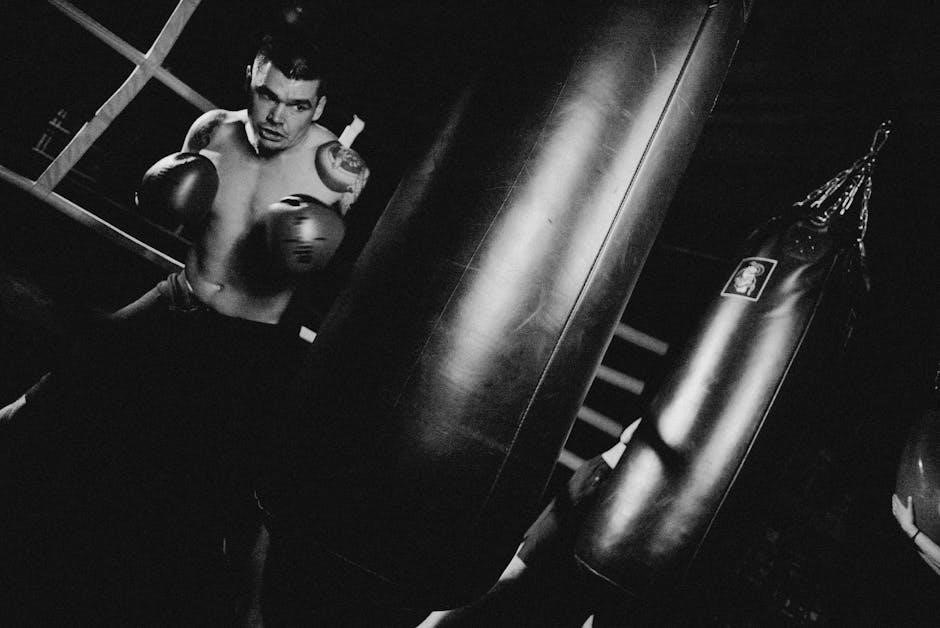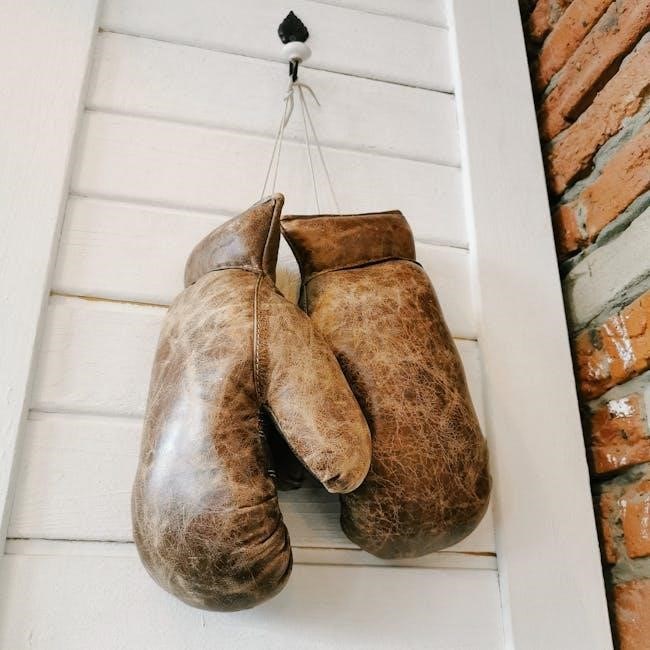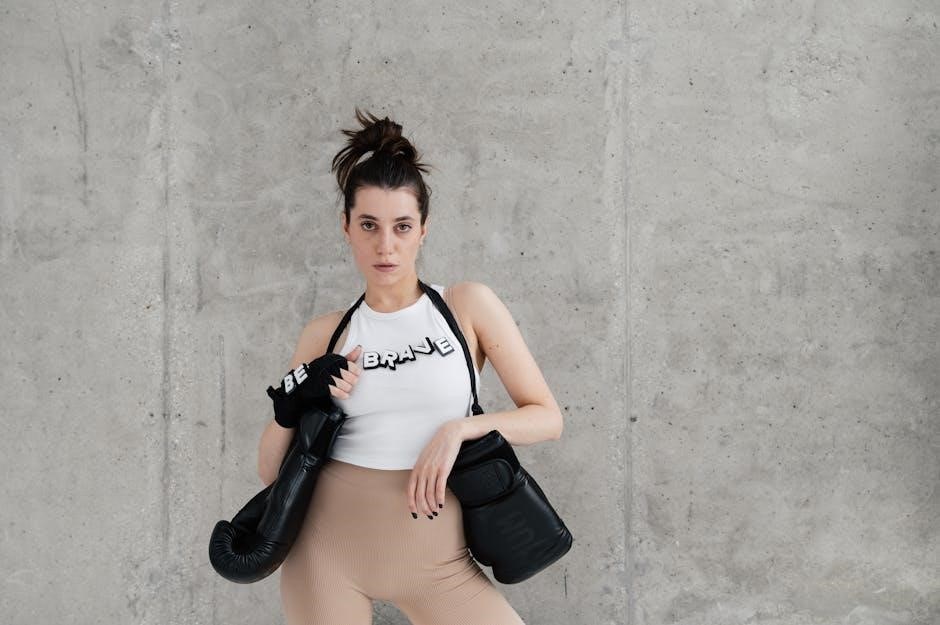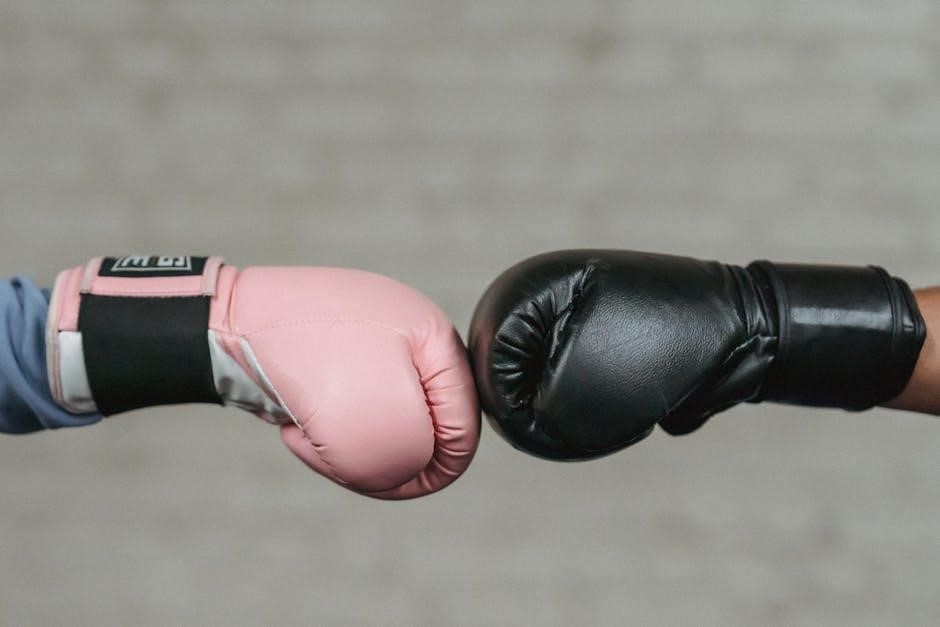Welcome to our boxing gloves sizing guide. Proper fit is crucial for safety and performance. This guide helps choose gloves based on hand size, weight, and intended use.
Why Proper Sizing Matters
Proper sizing is essential for comfort, protection, and performance. Ill-fitting gloves can lead to discomfort, poor technique, or even injury. Gloves that are too tight may restrict hand movement, while those too loose may fail to provide adequate support. Correct sizing ensures optimal protection for your hands during training or competition. It also enhances your ability to deliver precise and powerful punches. Choosing the right size prevents blisters, swelling, and long-term damage. Proper fit is crucial for both training and sparring, ensuring a safer and more effective boxing experience.
Overview of Key Factors in Glove Sizing
Key factors in glove sizing include hand circumference, weight class, and intended use. Hand circumference is measured around the knuckles to determine size. Weight class helps match glove ounces to body size. Intended use, such as training, sparring, or professional fighting, influences padding and weight. Proper sizing ensures safety, comfort, and performance. Each factor contributes to selecting gloves that provide adequate protection, support, and flexibility. Balancing these elements ensures the best fit for your needs. These considerations guide the selection process for optimal results.
Measuring Your Hand for the Perfect Fit
Measure your dominant hand’s circumference around the knuckles to determine your glove size. This ensures a snug, protective, and comfortable fit for optimal performance and safety.
How to Measure Hand Circumference

To measure your hand circumference, wrap a flexible tape measure around the widest part of your hand, just below the knuckles. Ensure the tape is snug but not tight. Record the measurement in inches. This will help determine your glove size. For accuracy, measure your dominant hand and consider the thickness of your hand wraps. If unsure, opt for the larger size to ensure a comfortable fit. Proper measurement ensures optimal protection and performance while training or competing.
Understanding Hand Size Categories

Hand size categories are based on the circumference of your hand, measured below the knuckles. Categories typically include Small (6-7.5 inches), Medium (7.5-8.5 inches), Large (8.5-9.5 inches), and Extra-Large (9.5+ inches). These categories help determine the appropriate glove size, ensuring a snug yet comfortable fit. Proper fit is essential for protection and performance. By understanding your hand size category, you can select gloves that provide adequate support and cushioning. Always consider hand wraps when sizing, as they add bulk. Accurate sizing ensures optimal comfort and effectiveness during training or competition.
Weight Class and Glove Size
Your weight class influences the ideal glove size. Lighter weight classes (under 100lbs) often use 8-10oz gloves, while heavier classes may require 14-16oz for better protection.
Glove Sizes for Different Weight Classes
Glove sizes vary based on weight classes to ensure proper protection and performance. For youth (up to 100lbs), 6-8oz gloves are recommended. Regular (100-150lbs) boxers typically use 10-12oz, while large (150-175lbs) and extra-large (175lbs+) prefer 14-16oz. These sizes provide adequate padding for impact absorption. Remember, your hand size and training type also influence the fit; Always consider personal comfort and measure your hand to confirm the best size for your needs. Proper sizing ensures safety and optimal performance during training or competition.
Recommended Ounces by Weight Category
Glove weight is tailored to weight categories to ensure safety and performance. For boxers under 100lbs (youth), 6-8oz gloves are ideal. Those in the 100-125lbs range typically use 8-10oz, while 125-150lbs boxers prefer 10-12oz. Heavier boxers (150lbs and above) often opt for 14-16oz for added padding. These recommendations ensure proper protection and comfort. Always consider your hand size and training type when selecting. Personal preference may vary, so try gloves on if possible to confirm the best fit for your needs and training style.


Intended Use and Glove Size

Glove size varies based on usage. Training, sparring, and professional fights require different padding and weights. Choosing the right size ensures optimal performance and protection during each activity.
Training vs. Sparring Gloves
Training gloves are designed for pad work and bag training, typically weighing between 12 to 16 ounces, offering adequate padding for heavy impact. Sparring gloves prioritize protection and movement, usually ranging from 14 to 16 ounces, with a focus on shock absorption and flexibility. The weight and padding thickness differ to suit specific training needs, ensuring safety and performance in both scenarios. Choosing the right type ensures optimal protection and functionality during sessions. Proper fit is essential for both comfort and effectiveness in training or sparring.
Professional Fighting Gloves
Professional fighting gloves are designed for competition, typically weighing between 8 to 10 ounces, depending on the weight class. These gloves prioritize both protection and dexterity, ensuring fighters can execute techniques effectively. They are made with high-quality materials for durability and have a snug fit to minimize hand movement. The padding is strategically distributed to provide optimal shock absorption while maintaining a lightweight feel. Professional gloves must meet regulatory standards to ensure fair play and safety during matches. Proper sizing is critical to comply with competition rules and enhance performance.

Boxing Gloves Size Chart
Refer to the chart below for general size guidelines. Glove sizes range from 6 to 16 ounces, correlating with hand circumference and intended use. Proper fit ensures safety and performance.
General Size Guidelines

Glove sizes typically range from 6 to 16 ounces. Lighter gloves are for smaller hands and youth boxers, while heavier gloves suit larger hands and sparring; Measure hand circumference around the knuckles. Small gloves (6-7.5 inches) are for youth and lighter individuals. Medium (7.5-9 inches) suits most adults. Large gloves (9+ inches) are for heavier boxers. Always choose snug fit for optimal performance and protection. Size charts vary by brand, so consult specific manufacturer guidelines for best results.
Weight and Hand Size Correlation
Your weight and hand size are key factors in selecting the right boxing gloves. Smaller hands (6-7.5 inches) typically suit lighter boxers (up to 100 lbs), requiring 6-8 oz gloves. Medium hands (7.5-9 inches) fit boxers weighing 101-150 lbs, who often use 10-12 oz gloves. Larger hands (9+ inches) are common for heavier boxers (151+ lbs), who prefer 14-16 oz gloves. This correlation ensures proper fit, protection, and performance. Use this as a general guide, but consider individual preferences and training needs when making your final choice.

Common Mistakes in Choosing Glove Size
Avoid errors like ignoring proper hand measurement or not considering your training type. These oversights can lead to poor fit, discomfort, and reduced performance in the ring.
Ignoring Hand Measurement
Ignoring hand measurement is a common mistake that can lead to poorly fitting gloves. Proper measurement ensures a snug, comfortable fit, while a wrong size can cause discomfort or limited dexterity. A glove that’s too tight may restrict movement, while one that’s too loose can shift during training, reducing protection. Always measure your hand circumference to determine the ideal size. Use a tape measure around the knuckles of your dominant hand for accuracy. Neglecting this step can result in inadequate support and increased risk of injury during training or sparring.
Not Considering Intended Use
Not considering the intended use of boxing gloves is another common error. Gloves are designed for specific purposes, such as training, sparring, or professional fights. Training gloves prioritize padding for heavy bag work, while sparring gloves balance protection and mobility. Professional gloves are lighter and tighter-fitting for competitions. Using a glove outside its intended use can compromise performance and safety. For example, training gloves may be too bulky for sparring, and professional gloves may lack padding for intense workouts. Always match your glove size to its primary function for optimal results and protection.
Selecting the right boxing gloves ensures optimal performance and safety. Consider hand size, weight, and intended use to make an informed decision. Follow this guide for the best fit.
Final Tips for Selecting the Right Size
Always measure your hand circumference and consider your weight class. Ensure the gloves fit snugly but allow for hand wraps. Choose sizes based on intended use—training, sparring, or professional fights. If unsure, opt for a slightly larger size for comfort. Refer to brand-specific size charts, as sizing can vary. Prioritize both protection and dexterity for optimal performance. Remember, proper fit enhances safety and effectiveness in training or competition. By following these tips, you’ll find the perfect pair of boxing gloves tailored to your needs.




